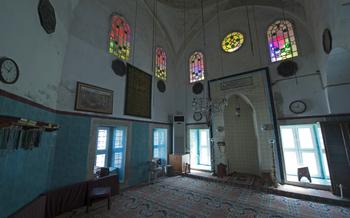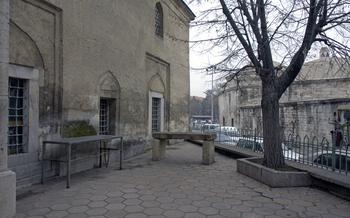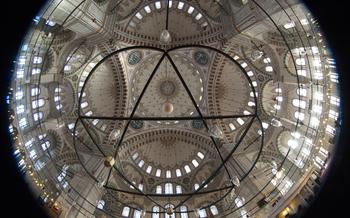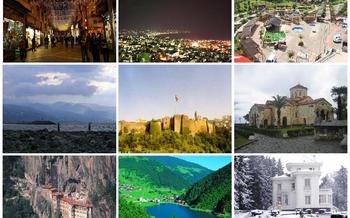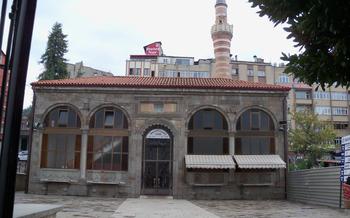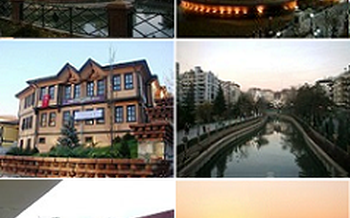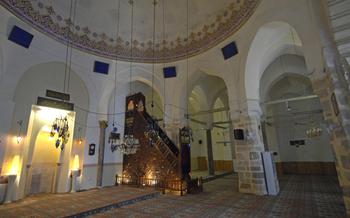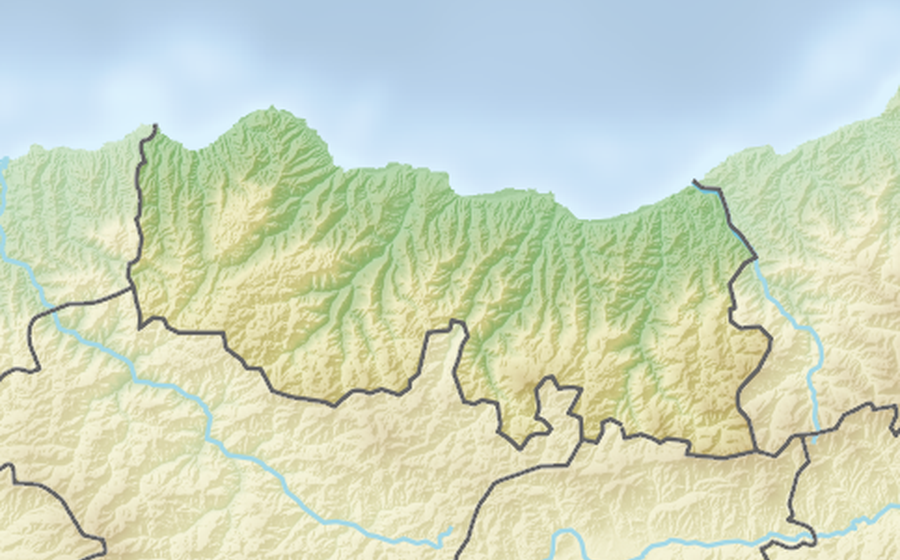
Kireçhane Mosque
- The Antiquity of Kireçhane Mosque
- Reaching the Mosque
- Exploring the Mosque's Exterior
- Delving into the Mosque's Interior
- Historical Significance
- Architectural Marvels
- Prayer and Worship
- Cultural Importance
- UNESCO World Heritage Site
- The Mosque's Surroundings
- Contemporary Use and Activities
- Photography and Documentation
- Local Customs and Etiquette
- Insider Tip: Unveiling the Mosque's Essence
The Antiquity of Kireçhane Mosque
The Kireçhane Mosque, a testament to the rich history of Trabzon, Turkey, stands as a beacon of Islamic heritage and architectural grandeur. Built in the 15th century during the reign of the Ottoman Empire, the mosque holds significant historical and cultural value. Its unique architectural style, intricate stonework, and decorative elements reflect the fusion of Islamic and Byzantine influences, making it a captivating sight for visitors from around the world.
The mosque's construction is attributed to the renowned Ottoman architect, Mimar Sinan, who is celebrated for his contributions to Islamic architecture. The mosque's design showcases his masterful blend of traditional and innovative elements, resulting in a structure that is both aesthetically pleasing and functionally efficient.
Reaching the Mosque
The Kireçhane Mosque is situated at the heart of Trabzon's historic center, a vibrant neighborhood brimming with cultural charm. To reach the mosque, visitors can embark on a scenic walk through the cobbled streets, admiring the traditional Ottoman-style houses and shops. Alternatively, public transportation options are readily available, with buses and taxis servicing the area.
For those arriving by car, parking is limited in the immediate vicinity of the mosque. However, several public parking facilities are located within a short walking distance. The mosque's accessibility for people with disabilities is commendable, with designated parking spaces and barrier-free entrances ensuring a seamless visit for all.
Exploring the Mosque's Exterior
The Kireçhane Mosque stands as a testament to the architectural prowess of its builders, showcasing a harmonious blend of Islamic and Byzantine influences. Its exterior is a captivating spectacle of intricate stonework and carvings, each detail meticulously crafted to convey a profound sense of sacredness and awe. The mosque's minaret, a beacon of faith piercing the sky, is adorned with exquisite geometric patterns, reflecting the rich mathematical and artistic traditions of the period. Decorative elements abound, from the delicate arabesques adorning the doorways to the elegant calligraphy adorning the friezes, each element contributing to the mosque's visual splendor. Situated amidst the bustling urban landscape of Trabzon, the Kireçhane Mosque stands as a majestic symbol of faith, its architectural grandeur harmonizing seamlessly with the vibrant city life surrounding it.
Delving into the Mosque's Interior
The interior of the Kireçhane Mosque is as awe-inspiring as its exterior. Step inside, and you'll be greeted by a serene and spacious prayer hall, adorned with intricate details that reflect the mosque's rich history and craftsmanship.
The layout of the prayer hall is simple yet elegant, with rows of carpets arranged in perfect alignment, inviting worshippers to immerse themselves in prayer. The focal point of the hall is the mihrab, a niche in the wall that indicates the direction of Mecca. It's adorned with exquisite tile work and intricate carvings, showcasing the artistry and devotion of the mosque's builders.
Next to the mihrab stands the minbar, a pulpit from which the imam delivers sermons. It's crafted from finely carved wood and features intricate geometric patterns and calligraphy. Each element of the minbar is a testament to the skill and dedication of the artisans who created it.
The mosque's walls are adorned with verses from the Quran, inscribed in beautiful calligraphy. These inscriptions not only add to the aesthetic appeal of the mosque but also serve as a reminder of the spiritual significance of the space. The harmonious blend of architecture, calligraphy, and ornamentation creates a truly immersive and uplifting ambiance, inviting worshippers to connect with their faith.
Historical Significance
The foundation of the Kireçhane Mosque can be traced back to the early days of Ottoman rule in Trabzon. It is believed to have been constructed around the 15th century, during the reign of Sultan Mehmed II, the conqueror of Constantinople. The mosque played a crucial role in the Ottoman Empire, serving as a significant religious and cultural center in the region. It functioned as a place of worship for the Muslim community and also hosted various educational and social activities. Over the centuries, the mosque underwent several renovations and restorations, reflecting the changing architectural styles and tastes of the period. In the late 20th century, a comprehensive restoration project was undertaken to preserve this historical gem for future generations. Today, the Kireçhane Mosque stands as a testament to the rich cultural heritage and architectural legacy of Trabzon, attracting visitors from around the world.
Architectural Marvels
The Kireçhane Mosque stands out for its distinctive architectural features, seamlessly blending Islamic and Byzantine elements. Its prayer hall, adorned with intricate stonework and carvings, reflects the mosque's rich cultural heritage. Geometric patterns and floral motifs adorn the interior, showcasing the craftsmanship of skilled artisans.
The mosque's dome, a remarkable architectural achievement, is supported by four massive pillars, creating a sense of grandeur. The pointed arches, a characteristic of Gothic architecture, lend a unique charm to the edifice. The minaret, rising high above the mosque, serves as a beacon of faith, guiding the faithful to the sacred space.
The Kireçhane Mosque's fusion of Islamic and Byzantine styles contributed significantly to the development of later Ottoman architecture. Its innovative design influenced numerous mosques and religious structures throughout the empire, leaving a lasting legacy on architectural history.
Prayer and Worship
The Kireçhane Mosque stands as a testament to its enduring role as a place of worship, serving the Muslim community of Trabzon for centuries. Congregational prayers echo within its walls five times daily, uniting the faithful in devotion. During the holy month of Ramadan, the mosque transforms into a hub of spiritual fervor, hosting special prayers, Quran recitations, and religious gatherings. Visitors are welcome to join the congregation for these events, experiencing the mosque's vibrant spiritual atmosphere firsthand.
Respectful behavior is essential when visiting the mosque during prayer times. Visitors are requested to maintain silence and refrain from disturbing the worshippers. Modest dress is also expected, with both men and women covering their shoulders and knees. By observing these customs, visitors can show their respect for the sacredness of the mosque and its role in the Muslim community.
Cultural Importance
The Kireçhane Mosque stands as a testament to Trabzon's rich cultural heritage, embodying the city's Islamic traditions and values. Its existence serves as a reminder of the profound influence of Islam on the region's history, art, and architecture. The mosque has played a pivotal role in preserving and transmitting Islamic knowledge and practices, contributing to the cultural identity and spiritual fabric of Trabzon.
As a place of worship and communal gathering, the Kireçhane Mosque has fostered a sense of community and belonging among the city's Muslim population. It has served as a venue for religious ceremonies, celebrations, and educational activities, strengthening the bonds of faith and camaraderie within the community. The mosque's presence has helped to shape the cultural landscape of Trabzon, infusing it with a distinct Islamic character that is reflected in its architecture, traditions, and way of life.
UNESCO World Heritage Site
In recognition of its outstanding universal value, the Kireçhane Mosque was inscribed on the UNESCO World Heritage List in 20This prestigious designation highlights the mosque's exceptional cultural and historical significance, transcending national boundaries and becoming a part of humanity's shared heritage.
The mosque met several criteria for inclusion on the World Heritage List. Firstly, it represents a unique architectural fusion of Islamic and Byzantine styles, showcasing the rich cultural interactions that shaped the region. Secondly, the mosque's well-preserved state and continuous use as a place of worship demonstrate its enduring significance in the religious and cultural life of Trabzon.
As a UNESCO World Heritage Site, the Kireçhane Mosque joins a select group of landmarks recognized for their outstanding value to humanity. This designation not only safeguards the mosque's preservation and protection but also raises awareness of its importance as a cultural treasure that transcends borders and time.
The Mosque's Surroundings
Venturing beyond the mosque's sacred confines, visitors can immerse themselves in the vibrant tapestry of Trabzon's historic neighborhood. This atmospheric quarter is a treasure trove of architectural wonders, with narrow cobblestone streets winding past centuries-old houses, shops, and landmarks.
A short stroll from the mosque leads to the imposing Trabzon Castle, a formidable fortress that once guarded the city from invaders. Its towering walls and imposing gates offer a glimpse into Trabzon's rich military history.
For those seeking a culinary adventure, the neighborhood is home to an array of traditional Turkish restaurants and cafes. Savor the delectable flavors of local specialties such as Karadeniz pidesi, a crispy flatbread topped with cheese and meat, or sample the freshly caught seafood from the Black Sea.
Shoppers will delight in the abundance of traditional handicrafts and souvenirs available in the local markets. From intricately woven carpets to gleaming copperware, there's something to suit every taste and budget.
Whether you're seeking historical exploration, culinary indulgence, or a shopping spree, the surroundings of Kireçhane Mosque offer a wealth of experiences that will enrich your visit to Trabzon.
Contemporary Use and Activities
The Kireçhane Mosque continues to serve as a vibrant hub for religious and community activities, perpetuating its significance in contemporary times. Beyond its role as a place of worship, the mosque hosts a range of educational programs and cultural events. These initiatives aim to foster a deeper understanding of Islamic heritage, promote interfaith dialogue, and contribute to the cultural enrichment of the community. The mosque's spacious courtyard often serves as a venue for exhibitions, showcasing local art, history, and craftsmanship. By embracing these contemporary initiatives, the Kireçhane Mosque remains a dynamic and relevant institution, bridging the past and the present while contributing to the cultural tapestry of Trabzon.
Photography and Documentation
The Kireçhane Mosque, with its stunning architecture and intricate details, offers ample opportunities for photography enthusiasts. Capturing the mosque's beauty through the lens can be a rewarding experience, allowing you to preserve memories and share the mosque's grandeur with others. However, it is important to remember that the mosque is a sacred religious space, and photography should be conducted respectfully.
Before taking any photographs, it is advisable to seek permission from the mosque's authorities or the local community. This shows respect for the sanctity of the space and ensures that you are not causing any disruption to ongoing religious activities. When photographing the mosque's interior, be mindful of the privacy of worshippers and avoid capturing their faces or any sensitive details.
In addition to capturing the mosque's overall grandeur, take the time to focus on its intricate details. The stonework, carvings, and decorative elements are all unique and contribute to the mosque's architectural significance. Close-up shots of these details can reveal the craftsmanship and artistry that went into the mosque's construction.
Documenting the mosque's architectural features is also important for preserving its history and legacy. Detailed photographs can serve as a valuable resource for researchers, architects, and historians studying the mosque's design and evolution over time.
Remember to be mindful of your surroundings and respectful of the mosque's sanctity. By following these guidelines, you can capture the beauty of the Kireçhane Mosque while preserving its significance as a sacred religious space.
Local Customs and Etiquette
When visiting the Kireçhane Mosque, it is essential to be mindful of local customs and traditions. Dressing modestly and respectfully is highly recommended, ensuring that your attire covers your shoulders and knees. It is considered inappropriate to wear shorts, tank tops, or revealing clothing. Upon entering the mosque, removing your shoes and placing them neatly on the designated shelves is customary. Maintaining a quiet and respectful demeanor while inside the mosque is essential, avoiding loud conversations or disruptive behavior. Photography is generally permitted within the mosque, but it is crucial to seek permission from the mosque's caretaker or officials before taking any pictures. When interacting with the local community, a friendly and respectful attitude goes a long way. A simple greeting in Turkish, such as "Merhaba" (Hello) or "Iyi günler" (Good day), can break the ice and show your respect for the local culture.
Insider Tip: Unveiling the Mosque's Essence
To truly immerse yourself in the spiritual essence of the Kireçhane Mosque, consider visiting during the prayer times. Witnessing the mosque come alive with the rhythmic chants of the congregation and the palpable devotion of the worshippers is an awe-inspiring experience that offers a glimpse into the heart of the Muslim faith.
Beyond the mosque, the surrounding neighborhood holds a treasure trove of hidden gems. Take the time to explore the ancient city walls, remnants of Trabzon's rich history, and delve into the vibrant local markets, where you can discover unique handicrafts and savor the flavors of traditional Turkish cuisine.

